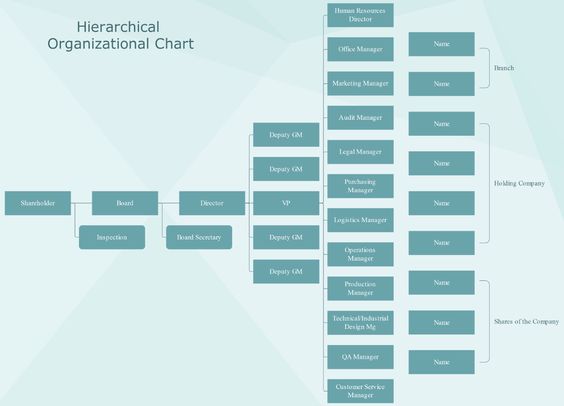In an organization, the manager usually deals with two types of structures namely, formal organization and informal organization. In case of formal structure, everything is planned and the managers have complete knowledge over every work to be completed. Whereas, in informal structure, there are no prescribed plans according to which the organization must run.
The seven popular organizational structures include:
- Line organizational structure
- Staff organizational structure
- Line and staff organizational structures
- Divisional organizational structure
- Project organizational structure
- Matrix organizational structure
- Hybrid organizational structure

Let’s take a tour of the different organizational structures by including their pros and cons:
1. Line organizational structures
The line organizational structure goes by its name where it is comprised of having only a direct or vertical relationship with each levels of the organization. Their main aim is to accomplish the given goal of the firm.
Pros:
- Takes less time when it’s time for decision making.
- Easy to understand and has flexibility in work.
- It simplifies the relationship between the different levels of relationships present in the organization.
Cons:
- Managers should have in-depth knowledge about everything as employees become dependent upon them.
- As the organization grows day by day, the structure becomes more unproductive.
2. Staff organizational structures
In case of staff or functional organizational structure, the employees in the lowest line of structure have to follow orders from the higher management. There are the staff managers and the line supervisors who take decisions from their level of management, thus there is a conflict between the two management structures.
Pros:
- It has the most knowledgeable and best decision making managers and supervisors who further help the organization to achieve its goals and grow.
- All the managers and supervisors have direct authoritative power which lets them make decisions fast.
Cons:
- Due to extensive power in each higher level managers and supervisors, a conflict arises while making the decisions into work.
3. Line and staff organizational structures
The organizations which are very large comprises of line and staff organizational structures. The management structures relationships are quite direct and have no barrier between the communications.
Pros:
- There are no barriers in between the management levels thus providing the communication to be smooth and direct. This makes the work structure more flexible.
- The experience and knowledge are prized in a line and staff organizational structure.
Cons:
- Due to smooth relationship between the line and staff managers, the coordination may disrupt between them leading to conflicts.
4. Divisional organizational structure
In case of divisional structure the management works in the form of separate departments. It is either scattered based upon the geographic location or the types of products.
5. Project organizational structure
In project organizational structures the experienced and the best team member’s work together to take decisions regarding the organization. it flows in all four directions i.e. upwards, downwards, horizontally and vertically.
Pros:
- As it is based on a single project so it does not repeat itself and is also unique every time.
- The work is completed in a disciplined way and the specific goal is achieved.
Cons:
- As the higher authorities work together more conflicts arise which makes the work slower.
- Due to such coordination there are informal relationships that occur between different management levels.
6. Matrix organizational structure
Same as Project organizational structure, the matrix structure also makes a team of the expertise from different levels of management to achieve a target.
Pros:
- If any changes need to be made then it takes less time as there are more expertise to monitor.
- There lies a flexible use of every resource available.
Cons:
- Conflicts arise due to huge number of higher management heads.
- Cost incurred for administration is very high.
7. Hybrid organizational structure
The hybrid organizational structure consists of each of the structures mentioned above. It is mostly used in case of multinational companies as it has a huge number of employees.
Pros:
- As there are divisions and different departments, they run in a smooth and flexible manner.
- The goal is achieved in a competent and experienced manner.
Cons:
- Conflicts arise between the department heads as everyone has been given the right of authority.
